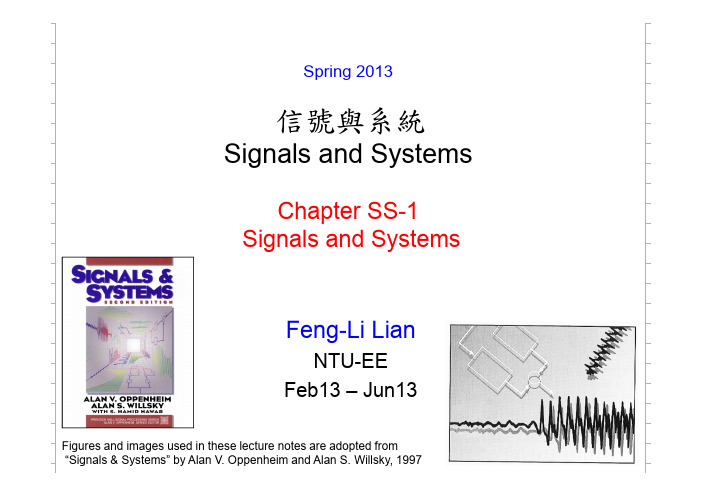Signals and Systems(1)
- 格式:ppt
- 大小:4.93 MB
- 文档页数:90






S T R U C T U R E A N DI N T E R P R E T A T I O N O FSignals andSystemsEdward A.LeePravin VaraiyaUNIVERSITY OF CALIFORNIA AT BERKELEYPrefaceT his textbook is about signals and systems,a discipline rooted in the in-tellectual tradition of electrical engineering(EE).This tradition,however,hasevolved in unexpected ways.EE has lost its tight coupling with the“electrical.”Electricity provides the impetus,the potential,but not the body of the subject.How else could microelectromechanical systems(MEMS)become so importantin EE?Is this not mechanical engineering?Or signal processing?Is this not mathe-matics?Or digital networking?Is this not computer science?How is it that controlsystem techniques are profitably applied to aeronautical systems,structural me-chanics,electrical systems,and options pricing?This book approaches signals and systems from a computational point ofview.It is intended for students interested in the modern,highly digital problemsof electrical engineering,computer science,and computer engineering.In par-ticular,the approach is applicable to problems in computer networking,wirelesscommunication systems,embedded control,audio and video signal processing,and,of course,circuits.A more traditional introduction to signals and systems would be biasedtoward the latter application,circuits.It would focus almost exclusively on lineartime-invariant systems,and would develop continuous-time modelsfirst,withdiscrete-time models then treated as an advanced topic.The discipline,after all,grew out of the context of circuit analysis.But it has changed.Even pure EExiiixiv Prefacegraduates are more likely to write software than to push electrons,and yet westill recognize them as electrical engineers.The approach in this book benefits students by showing from the start that the methods of signals and systems are applicable to software systems,andmost interestingly,to systems that mix computers with physical devices such ascircuits,mechanical control systems,and physical media.Such systems havebecome pervasive,and profoundly affect our daily lives.The shift away from circuits implies some changes in the way the method-ology of signals and systems is presented.While it is still true that a voltage thatvaries over time is a signal,so is a packet sequence on a network.This text de-fines signals to cover both.While it is still true that an RLC circuit is a system,so is a computer program for decoding Internet audio.This text defines systemsto cover both.While for some systems the state is still captured adequately byvariables in a differential equation,for many it is now the values in registers andmemory of a computer.This text defines state to cover both.The fundamental limits also change.Although we still face thermal noise and the speed of light,we are likely to encounter other limits—such as complexity,computability,chaos,and,most commonly,limits imposed by other humanconstructions—before we get to these.A voiceband data modem,for example,uses the telephone network,which was designed to carry voice,and offers asimmutable limits such nonphysical constraints as its3kHz bandwidth.This hasno intrinsic origin in the physics of the network;it is put there by engineers.Similarly,computer-based audio systems face latency and jitter imposed by theoperating system.This text focuses on composition of systems so that the limitsimposed by one system on another can be understood.The mathematical basis for the discipline also changes.Although we still use calculus and differential equations,we frequently need discrete math,set theory,and mathematical logic.Whereas the mathematics of calculus and differentialequations evolved to describe the physical world,the world we face as systemdesigners often has nonphysical properties that are not such a good match forthis mathematics.This text bases the entire study on a highly adaptable formalismrooted in elementary set theory.Despite these fundamental changes in the medium with which we operate, the methodology of signals and systems remains robust and powerful.It is themethodology,not the medium,that defines thefield.The book is based on a course at Berkeley taught over the past four years to more than2,000students in electrical engineering and computer sciences.Thatexperience is reflected in certain distinguished features of this book.First,nobackground in electrical engineering or computer science is assumed.Readersshould have some exposure to calculus,elementary set theory,series,first-orderlinear differential equations,trigonometry,and elementary complex numbers.The appendices review set theory and complex numbers,so this background isless essential.Preface xvApproachThis book is about mathematical modeling and analysis of signals and systems,applications of these methods,and the connection between mathematical mod-els and computational realizations.We develop three themes.Thefirst theme isthe use of sets and functions as a universal language to describe diverse sig-nals and systems.Signals—voice,images,bit sequences—are represented asfunctions with an appropriate domain and range.Systems are represented asfunctions whose domain and range are themselves sets of signals.Thus,for exam-ple,a modem is represented as a function that maps bit sequences into voice-likesignals.The second theme is that complex systems are constructed by connectingsimpler subsystems in standard ways—cascade,parallel,and feedback.The con-nections detennine the behavior of the interconnected system from the behav-iors of component subsystems.The connections place consistency requirementson the input and output signals of the systems being connected.Our third theme is to relate the declarative view(mathematical,“what is”)with the imperative view(procedural,“how to”).That is,we associate mathe-matical analysis of systems with realizations of these systems.This is the heartof engineering.When EE was entirely about circuits,this was relatively easy,because it was the physics of the circuits that was being described by the math-ematics.Today we have to somehow associate the mathematical analysis withvery different realizations of the systems,most especially software.We make thisassociation through the study of state machines,and through the considerationof many real-world signals,which,unlike their mathematical abstractions,havelittle discernable declarative structure.Speech signals,for instance,are far moreinteresting than sinusoids,and yet many signals and systems textbooks talk onlyabout sinusoids.ContentWe begin in chapter1by describing signals as functions,focusing on character-izing the domain and the range for familiar signals that humans perceive,suchas sound,images,video,trajectories of vehicles,as well as signals typically usedby machines to store or manipulate information,such as sequences of words orbits.In chapter2,systems are described as functions,but now the domain andthe range are themselves sets of signals.The telephone handset converts voiceinto an analog electrical signal,and the line card in the telephone central officeconverts the latter into a stream of bits.Systems can be connected to form a morecomplex system,and the function describing these more complex systems is acomposition of functions describing the component systems.xvi PrefaceCharacterizing concretely the functions that describe signals and systems is the content of the book.We begin to characterize systems in chapter3usingthe notion of state,the state transition function,and the output function,all inthe context offinite-state machines.In chapter4,state machines are composedin various ways(cascade,parallel,and feedback)to make more interesting sys-tems.Applications to feedback control illustrate the power of the state machinemodel.In chapter5,time-based systems are studied in more depth,first with discrete-time systems(which have simpler mathematics),and then with contin-uous-time systems.We define linear time-invariant(LTI)systems as infinite statemachines with linear state transition and output functions and zero initial state.The input–output behavior of these systems is now fully characterized by theirimpulse response.Chapter6bridges thefinite-state machines of chapters3and4with the time-based systems of chapter5,showing that they can be combined in useful waysto get hybrid systems.This greatly extends the applicability of LTI systems,be-cause,although most systems are not LTI,many have modes of operation thatare approximately LTI.The concept of modal models is illustrated with super-visory control systems.This chapter alone would justify the unified modelingapproach in this text,because it offers a glimpse of a far more powerful concep-tual framework than either state machines or LTI methods can offer alone.Chapter7introduces frequency decomposition of signals;chapter8intro-duces frequency response of LTI systems;and chapter9brings the two togetherby discussingfiltering.The approach is to present frequency domain concepts asa complementary toolset,different from that of state machines,and much morepowerful when applicable.Frequency decomposition of signals is motivatedfirstusing psychoacoustics,and gradually developed until all four Fourier transforms(the Fourier series,the Fourier transform,the discrete-time Fourier transform,and the discrete Fourier transform)have been described.We linger on thefirstof these,the Fourier series,since it is conceptually the easiest,and then morequickly present the others as generalizations of the Fourier series.LTI systemsyield best to frequency-domain analysis because of the property that complexexponentials are eigenfunctions.Consequently,they are fully characterized bytheir frequency response—the main reason that frequency domain methods areimportant in the analysis offilters and feedback control.Chapter10covers classical Fourier transform material such as properties of the four Fourier transforms and transforms of basic signals.Chapter11appliesfrequency domain methods to a study of sampling and aliasing.Chapters12,13,and14extend frequency-domain techniques to include the Z transform and the Laplace transform.Applications in signal processingand feedback control illustrate the concepts and the utility of the techniques.Mathematically,the Z transform and the Laplace transform are introduced asextensions of the discrete-time and continuous-time Fourier transforms to signalsthat are not absolutely summable or integrable.Preface xvii The unified modeling approach in this text is rich enough to describe a widerange of signals and systems,including those based on discrete events and thosebased on signals in time,both continuous and discrete.The complementarytools of state machines and frequency-domain methods permit analysis andimplementation of concrete signals and systems.Hybrid systems and modalmodels offer systematic ways to combine these complementary toolsets.Theframework and the tools of this text provide a foundation on which to buildlater courses on digital systems,embedded software,communications,signalprocessing,hybrid systems,and control.The Web siteThe book has an extensive companion Web site,/lee_varaiya.It includes:The laboratory component.A suite of exercises based on MATLAB andSimulink®∗help reconcile the declarative and imperative points of view.MATLAB is an imperative programming language.Simulink is a block dia-gram language,in which one connects blocks implementing simpler sub-systems to construct more interesting systems.It is much easier to quicklyconstruct interesting signals and systems using the extensive built-in librariesof MATLAB and Simulink than using a conventional programming languagelike C++,Java,or Scheme.These laboratory exercises involve audio,video,and images,which are much more interesting signals than sinusoids.The applets.An extensive set of interactive applets brings out the imperativeview and illustrates concepts of frequency analysis.These include speech,music,and image examples,interactive applets showingfinite Fourier seriesapproximations,and illustrations of complex exponentials and phasors.Instructor and student aids.A large set of Web pages,arranged by topic,can be used by the instructor in class and by students to review the material.These pages integrate many of the applets,and thus offer more interactiveand dynamic presentation material than what is possible with more conven-tional presentation material.At Berkeley,we use them in the classroom,as asupplement to the blackboard.Qualified instructors can download a snap-shot of the Web pages,including the applets,so a network connection is notrequired in the classroom.Additional sidebars.The Web site includes additional topics in sidebarform,beyond those in the text.For example,there is a discussion of imageencoding methods that are commonly used on the Web.Solutions.Solutions to exercises are available from the publisher to quali-fied instructors.∗MATLAB and Simulink are registered trademarks of The MathWorks,Inc.xviii PrefacePedagogical featuresThis book has a number of highlights that make it well suited as a textbook foran introductory course.1.“Probing Further”sidebars briefly introduce the reader to interesting exten-sions of the subject,to applications,and to more advanced material.Theyserve to indicate directions in which the subject can be explored.2.“Basics”sidebars offer readers with less mathematical background somebasic tools and methods.3.Appendix A reviews basic set theory and helps establish the notation usedthroughout the book.4.Appendix B reviews complex variables,making it unnecessary for studentsto have much background in this area.5.Key equations are boxed to emphasize their importance.They can serve asthe places to pause in a quick reading.In the index,the page numbers wherekey terms are defined are shown in bold.6.The exercises at the end of each chapter are annotated with the letters E,T,or C to distinguish those exercises that are mechanical(E for excercise)from those requiring a plan of attack(T for thought)and from those thatgenerally have more than one reasonable answer(C for conceptualization).NotationThe notation in this text is unusual when compared to standard texts on signalsand systems.We explain our reasons for this as follows:Domains and ranges.It is common in signals and systems texts to use theform of the argument of a function to define its domain.For example,x(n)is a discrete-time signal,while x(t)is a continuous-time signal;X(jω)is thecontinuous-time Fourier transform and X(e jω)is the discrete-time Fourier trans-form.This leads to apparent nonsense like x(n)=x(nT)to define sampling,orto confusion like X(jω)=X(e jω)even when jω=e jω.We treat the domain of a function as part of its definition.Thus,a discrete-time,real-valued signal is a function x:Integers→Reals,and its discrete-timeFourier transform is a function x:Reals→Complex.The DTFT itself is a functionwhose domain and range are sets of functions,DTFT:[Integers→Reals]→[Reals→Complex].Then we can unambiguously write X=DTFT(x).Functions as values.Most texts call the expression x(t)a function.A betterinterpretation is that x(t)is an element in the range of the function x.Thedifficulty with the former interpretation becomes obvious when talking aboutsystems.Many texts pay lip service to the notion that a system is a function byPreface xix introducing a notation like y(t)=T(x(t)).This makes it seem that T acts on thevalue x(t)rather than on the entire function x.Our notation includes set of functions,allowing systems to be defined asfunctions with such sets as the domain and range.Continuous-time convolution,for example,becomesConvolution:[Reals→Reals]×[Reals→Reals]→[Reals→Reals].We then introduce the notation∗as a shorthand,y=x∗h=Convolution(x,h),and define the convolution function by∀t∈Reals,y(t)=(x∗h)(t)= ∞−∞X(τ)y(t−τ)dτ.Note the careful parenthesization.The more traditional notation,y(t)=x(t)∗h(t),would seem to imply that y(t−T)=x(t−T)∗h(t−T).But it is not so!A major advantage of our notation is that it easily extends beyond LTI systems to the sorts of systems that inevitably arise in any real world application,such as mixtures of discrete event and continuous-time systems.Names of functions.We use long names for functions and variables when they have a concrete interpretation.Thus,instead of x we might use Sound.This follows a long-standing tradition in software,where readability is considerably improved by long names.By giving us a much richer set of names to use,this helps us avoid some of the preceding pitfalls.For example,to define sampling of an audio signal,we might writeSampledSound=Sampler T(Sound).It also helps bridge the gap between realizations of systems(which are often software)and their mathematical models.How to manage and understand this gap is a major theme of our approach.How to use this bookAt Berkeley,thefirst11chapters of this book are covered in a15-week,one-semester course.Even though it leaves Laplace transforms,Z transforms,and feedback control systems to a follow-up course,it remains a fairly intense ex-perience.Each week consists of three50-minute lectures,a one-hour problem session,and one three-hour laboratory.The lectures and problem sessions arexx Prefaceconducted by a faculty member while the laboratory is led by teaching assis-tants,who are usually graduate students,but are also often talented juniors orseniors.The laboratory component is based on MATLAB and Simulink,and is closely coordinated with the lectures.The text does not offer a tutorial on MATLAB,although the labs include enough material so that,combined with on-line help,they are sufficient.Some examples in the text and some exercises at the ends ofthe chapters depend on MATLAB.At Berkeley,this course is taken by all electrical engineering and computer science students,and is followed by a more traditional signals and systemscourse.That course covers the material in the last three chapters plus applica-tions offrequency-domain methods to collllnunications systems.The follow-upcourse is not taken by most computer science students.In a program that is morepurely electrical and computer engineering than ours,a better approach mightbe to spend two quarters or two semesters on the material in this text,since theunity of notation and approach would be better than having two disjoint courses,the introductory one using a modern approach,and the follow-up course usinga traditional one.AcknowledgmentsMany people have contributed to the content of this book.Dave Messerschmittconceptualized thefirst version of the course on which the book is based,andlater committed considerable departmental resources to the development ofthe course while he was chair of the EECS department at Berkeley.Randy Katz,Richard Newton,and Shankar Sastry continued to invest considerable resourcesin the course when they each took over as chair,and backed our efforts toestablish the course as a cornerstone of our undergraduate curriculum.This tookconsiderable courage,since the conceptual approach of the course was largelyunproven.Tom Henzinger probably had more intellectual influence over the approach than any other individual,and to this day we still argue in the halls about detailsof the approach.The view of state machines,of composition of systems,and ofhybrid systems owe much to Tom.Gerard Berry also contributed a great deal toour way of presenting synchronous composition.We were impressed by the approach of Harold Abelson and and Gerald Jay Sussman,in Structure and Interpretation of Computer Programs(MIT Press,1996),who confronted a similar transition in their discipline.The title of our bookshows their influence.Jim McLellan,Ron Shafer,and Mark Yoder influenced thisbook through their pioneering departure from tradition in signals and systems,DSP First—A Multimedia Approach(Prentice-Hall,1998).Ken Steiglitz greatlyinfluenced the labs with his inspirational book,A DSP Primer:With Applicationsto Digital Audio and Computer Music(Addison-Wesley,1996).A number of people have been involved in the media applications,exam-ples,the laboratory development,and the Web content associated with the book.Preface xxi These include Brian Evans and Ferenc Kovac.We also owe gratitude for thesuperb technical support from Christopher Hylands.Jie Liu contributed stickymasses example to the hybrid systems chapter,and Yuhong Xiong contributedthe technical stock trading example.Other examples and ideas were contributedby Steve Neuendorffer,Cory Sharp,and Tunc Simsek.For each of the past four years,about500students at Berkeley have taken thecourse that provided the impetus for this book.They used successive versionsof the book and the Web content.Their varied response to the course helpedus define the structure of the book and the level of discussion.The courseis taught with the help of undergraduate teaching assistants.Their commentshelped shape the laboratory material.Several colleagues kindly consented to be interviewed:Panos Antsaklis,Uni-versity of Notre Dame;Gerard Berry,Esterel Technologies;P.R.Kumar,Universityof Illinois,Urbana–Champaign;Dawn Tilbury,University of Michigan,Ann Arbor;Jeff Bier,BDTI;and Xavier Rodet,IRCAM,France.We thank them for sharing theexperience that encouraged them toward a career in electrical and computerengineering.Parts of this book were reviewed by more than30faculty members aroundthe country.Their criticisms helped us correct defects and inconsistencies in ear-lier versions.Of course,we alone are responsible for the opinions expressed inthe book,and the errors that remain.We especially thank:Jack Kurzweil,San JoseState University;Lee Swindlehurst,Brigham Young University;Malur K.Sundare-shan,University of Arizona;St´e phane Lafortune,University of Michigan;RonaldE.Nelson,Arkansas Tech University;Ravi Mazumdar,Purdue University;RatneshKumar,University of Kentucky;Rahul Singh,San Diego State University;PaulNeudorfer,Seattle University;R.Mark Nelms,Auburn University;Chen-Ching Liu,University of Washington;John H.Painter,Texas A&M University;T.Kirubarajan,University of Connecticut;James Harris,California Polytechnic State Universityin San Luis Obispo;Frank B.Gross,Florida A&M University;Donald L.Snyder,Washington University in St.Louis;Theodore E.Djaferis,University of Massachu-setts in Amherst;Soura Dasgupta,University of Iowa;Maurice Felix Aburdene,Bucknell University;and Don H.Johnson,Rice University.These reviews were solicited by Heather Shelstad of Brooks/Cole,DenisePenrose of Morgan-Kaufmann,and Susan Hartman and Galia Shokry of Addison-Wesley.We are grateful to these editors for their interest and encouragement.ToSusan Hartman,Galia Shokry and Nancy Lombardi we owe a special thanks;their enthusiasm and managerial skills helped us and others keep the deadlinesin bringing the book to print.It has taken much longer to write this book than we expected when we em-barked on this projectfive years ago.It has been a worthwhile effort nonetheless.Our friendship has deepened,and our mutual respect has grown as we learnedfrom each other.Rhonda Lee Righter and Ruth Varaiya have been remarkablysympathetic and encouraging through the many hours at nights and on week-ends that this project has demanded.To them we owe our immense gratitude.。